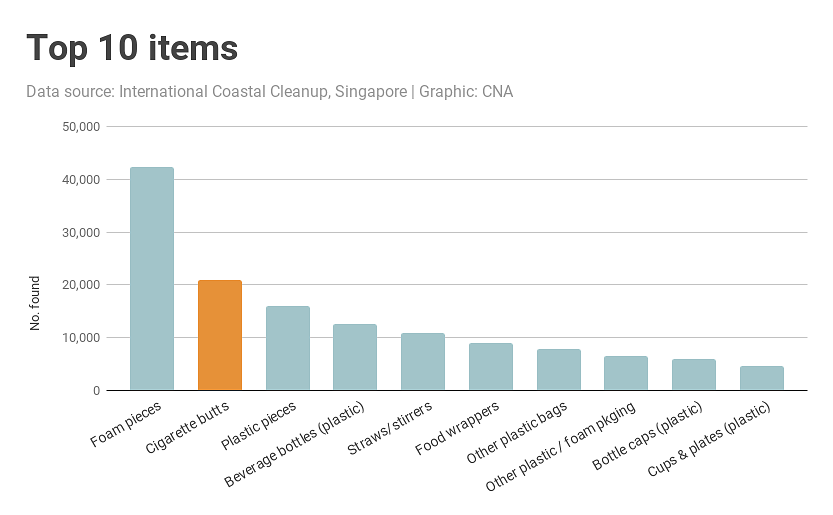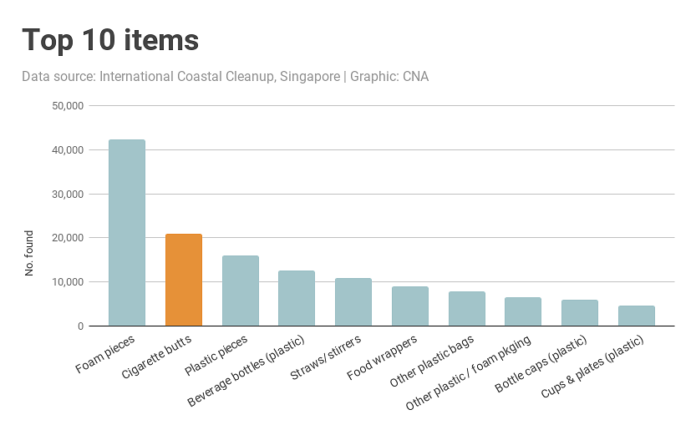SINGAPORE: Mention the phrase “marine litter” and chances are that images of plastic straws or bottles would be the first things to spring to mind.
Yet these items, while often found in local waters, pale in comparison to the number of cigarette butts littering the world’s shorelines.
Awareness of single-use plastic waste has been gaining traction in Singapore, most recently with the move by more than 270 food and beverage outlets to eliminate plastic straws.
READ: Phasing out plastic straws helps the environment, but more needs to be done, say observers
READ: Skipping plastic straws might not do much to stop marine pollution, experts say
But at a time when many other single-use plastic waste items – from plastic bags to single-use straws and cutlery – are facing growing public attention, have cigarette butts managed to slip under the radar?
For more than 20 years, Mr N Sivasothi, a senior lecturer at the National University of Singapore’s (NUS) Department of Biological Sciences, has been coordinating volunteer clean-ups along Singapore’s waterways and coastlines, including the local segment of global clean-up exercise the International Coastal Cleanup.
The annual event sees volunteers around the world collecting and documenting debris littering their respective countries’ shorelines, waterways and beaches.
The data is then collated and published by non-profit organisation Ocean Conservancy, which coordinates the International Coastal Cleanup.
Cigarette butts have consistently been among the top items found both locally and globally, Mr Sivasothi told CNA.
Last year 20,915 cigarette butts were found during the International Coastal Cleanup in Singapore.
This figure was nearly double the number of straws and stirrers found (10,885) and about 1.6 times the number of plastic beverage bottles (12,594). The butts were second only in numerical terms to litter from foam pieces (which have a higher propensity to break down into hundreds of smaller items).

“It’s consistently a top item,” said Mr Sivasothi, who is also a research associate at the Lee Kong Chian Natural History Museum.
It is also an item which, unlike other types of shoreline litter in Singapore, is more likely to stem from local littering.
Although a lot of litter along the country’s shores is washed in from the region, the concentration of cigarette butts along certain public beaches points to their local origin, according to Mr Sivasothi.
“We always say the highest number of cigarette butts will come from East Coast and Changi (beaches), and you’re not going to find any in, say, mangroves,” he said. “Because people go to the beach and smoke.”
“The profile when you go to the non-public beaches (is that) the cigarette butts disappear,” he added. “So they’re not being floated in. So it is a local issue.”
However, Mr Sivasothi pointed out that the nature of the annual clean-up – which is normally held on the third Saturday of September – means that it only represents a single snapshot in time, and volunteer efforts across the different clean-up locations across Singapore can vary.
“It’s a single data snapshot in September. And then, the effort is quite variable,” he said.
“Certain groups might scrutinise the trash line very closely and pick up thousands of cigarette butts. You send another group, they may focus on the larger items and miss all of that.”
Yet the prevalence of cigarette butts is consistent with the aggregated global International Coastal Cleanup tally, which has consistently seen cigarette butts topping its list of top-10 most-found items every year.
In its report for the 2010 International Coastal Cleanup, which marked the exercise’s 25th anniversary, Ocean Conservancy released data showing that about 52.9 million cigarettes/cigarette filters had been collected over the past 25 years of clean-ups – making up 32 per cent of total debris items and enough to fill 100 Olympic-sized swimming pools.

Graphic: Ocean Conservancy
BUTT WHAT’S THE PROBLEM?
A lot of people might not recognise cigarette butts as containing plastic – but they do, with the filters in cigarette butts made up of cellulose acetate, a type of plastic that does not readily biodegrade.
Thin cellulose acetate fibres are packed tightly to remove harmful contaminants from smoke before it is inhaled, with a single filter possibly containing more than 12,000 such fibres, according to Associate Professor Suresh Valiyaveettil at NUS’ chemistry department.
File photo of cigarette butts in Singapore. (Photo: Gaya Chandramohan)
The large amount of cigarette butt litter as well as the fact that cigarettes contain harmful chemicals that can leach out into the environment were cited as key concerns by the academic.
“Personally, I think cigarette butts are even more dangerous than any other plastic item owing to the large amounts and the harmful chemicals leaching from them,” he told CNA.
“Usually, single-use plastic items such as straws, plastic bags etc. are hydrophobic (do not mix with water) and therefore do not degrade in a short period,” he said. “They do contain a lot of additives, but the hydrophobicity of the object slows the leaching of small molecules into the environment from common plastic items.”
“In the case of cigarette butts, the tobacco absorbs moisture readily and many chemicals are released into the environment in a short period of time.”
These chemicals can be deadly to organisms in the environment, with a study published in the BMJ’s Tobacco Control journal finding cigarette butt leachate “acutely toxic” to representative marine and freshwater fish – sometimes at a lethal concentration (LC50) of about one cigarette butt per litre of water for certain types of fish.
And as with other types of plastic pollution, cigarette filters can disintegrate and eventually break into microplastics, according to NUS PhD student Amanda Lim, who studies the sources and impact of marine debris.
“Cigarette filters are made of cellulose acetate fibers, a variant of rayon,” she said. “Filters could disintegrate into microfibres and become microplastic.”
READ: You may be eating a credit card’s worth of plastic each week: Study
FILTERING OUT POTENTIAL CAUSES
One reason for the large amount of cigarette butt litter could come down to its relative lack of visibility, especially on sandy beaches, as compared to larger items such as a plastic bottle or brightly coloured straws.
Unlike in some other countries which have smoking bans on beaches, smoking is allowed on beaches in Singapore according to the National Environment Agency’s website.
“Singaporeans rarely talk about cigarette butts under the marine plastics issue,” said Mr Sivasothi, adding that global anti-plastic pollution campaigns also tend to focus on other items.
“I think visually it does not create as much impact. Visually they see the water bottles, the food containers and the plastic bags as the most visual component,” he said. “And then they hear about bans around the world, and bans around the world tend to be focussing on these components as well; water bottles, plastic bags, food containers.”
File photo of a plastic bottle discarded along a beach.
In addition, tossing away cigarette butts might not be viewed in the same light as other forms of littering, according to a sociological study of littering in Singapore commissioned by NEA in 2009.
Calling cigarette butt littering “a confounding behaviour”, the study found that the cultural acceptability of cigarette butt littering could be contributing to the issue.
“Smokers revealed that it is culturally acceptable and expected among the smoking circle to ‘flick the cigarette butt after smoking’ or ‘stub out the cigarette under the soles of their shoes’,” said the study. “One informant even emphasised that the flicking of cigarette butts ‘is something that is universal among smokers’ and a behaviour that is constantly portrayed in popular media and culture.”
“In fact, a few mentioned that it is very ‘manly’ to do so compared to carrying the cigarette butt all the way to the nearest bin.”
People might also not see cigarette butts as litter compared to bigger items, said the study.
“Many respondents rationalise that small items are not litter, for their perceived harm to the environment and aesthetics is negligible,” it concluded. “Thus, parking coupon tabs, cigarette butts and small pieces of paper are among the items rationalised as ‘not litter’.”
But ultimately cigarette butt litter still sits within a wider, longstanding plastic pollution issue, points out Mr Sivasothi.
“The message hasn’t changed you know, for more than a decade,” he said. “It’s that single-use consumer plastic represents the highest proportion of items that are polluting our seas.”
“So really if you say what’s the single message – (it’s) how do we cut down on plastic use?”





